By Scott Starr, Director of Marketing, Firetrace Intearnational
Fire is an ever present threat for bus and coach operators even though many fires go unreported because the blazes are not recorded in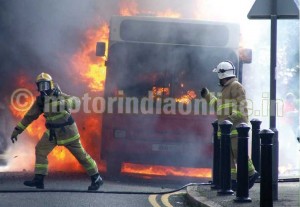 a central database. Damage to the vehicle can be extensive, lives may be put at risk and the operator’s reputation for safety can be irrevocably tarnished. While analysing the risks involved, a mention must be made of one solution that is reliably protecting the engine compartments and rechargeable energy storage systems of regenerative braking systems on more than 50,000 vehicles, including 15,000 buses and coaches in Europe, India, the Middle East and the US.
a central database. Damage to the vehicle can be extensive, lives may be put at risk and the operator’s reputation for safety can be irrevocably tarnished. While analysing the risks involved, a mention must be made of one solution that is reliably protecting the engine compartments and rechargeable energy storage systems of regenerative braking systems on more than 50,000 vehicles, including 15,000 buses and coaches in Europe, India, the Middle East and the US.
 There are numerous causes of bus and coach engine fires. In addition to the fuel and the risk of fuel line ruptures, there are a number of flammable liquids present throughout the engine compartment, including hydraulic, brake, automatic transmission and power steering fluids, plus combustible accumulated grease on the engine block, for which frayed or damaged electrical wiring can easily provide the ignition source. Certainly, these risks can be lessened by regular and diligent maintenance, but engine fire will remain a constant threat, and effective engine compartment fire detection and suppression is the only dependable means of ensuring that a minor fire does not escalate quickly into a major conflagration.
There are numerous causes of bus and coach engine fires. In addition to the fuel and the risk of fuel line ruptures, there are a number of flammable liquids present throughout the engine compartment, including hydraulic, brake, automatic transmission and power steering fluids, plus combustible accumulated grease on the engine block, for which frayed or damaged electrical wiring can easily provide the ignition source. Certainly, these risks can be lessened by regular and diligent maintenance, but engine fire will remain a constant threat, and effective engine compartment fire detection and suppression is the only dependable means of ensuring that a minor fire does not escalate quickly into a major conflagration.
Regenerative braking systems on hybrid diesel-electric buses, where energy that would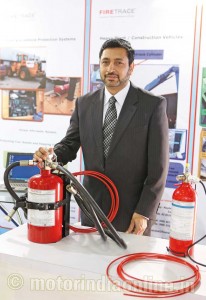 normally be wasted when braking is recycled and used to charge the batteries, deliver significantly better fuel economy with greatly reducing emissions compared with standard diesel engine buses. However, they are another potential fire risk that, again, is best eliminated by fitting a dedicated fire detection and suppression system around the rechargeable energy storage system.
normally be wasted when braking is recycled and used to charge the batteries, deliver significantly better fuel economy with greatly reducing emissions compared with standard diesel engine buses. However, they are another potential fire risk that, again, is best eliminated by fitting a dedicated fire detection and suppression system around the rechargeable energy storage system.
Dedicated protection & suppression
The dynamics of the airflow in and around an engine compartment when a bus or coach is in motion can seriously impair the performance and reliability of traditional detection and suppression systems when heat and flame that typically rise from the source of a fire may be propelled elsewhere. The inevitable build-up of dirt in and around engines, intense temperature variations and vibration are also factors that are known to cause traditional detection and suppression systems to fail to provide the essential fast and accurate fire detection and suppression.
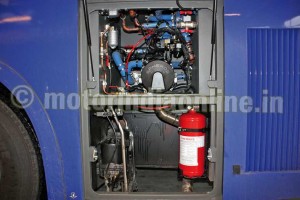 Firetrace International’s Firetrace resolves these challenges that affect both front and rear-engined vehicles, and can be fitted to new vehicles or retrofitted to existing buses and coaches. It is an automatic, self-seeking fire extinguishing system that provides round-the-clock unsupervised protection that requires neither electricity nor external power. It comprises an extinguishing agent cylinder attached to proprietary Firetrace Detection Tubing. This polymer tubing is a linear pneumatic heat and flame detector that is immune to vibration, shocks and temperature extremes found in bus engine and generator compartments. It was specially developed to deliver the desired temperature-sensitive detection and delivery characteristics in harsh environments.
Firetrace International’s Firetrace resolves these challenges that affect both front and rear-engined vehicles, and can be fitted to new vehicles or retrofitted to existing buses and coaches. It is an automatic, self-seeking fire extinguishing system that provides round-the-clock unsupervised protection that requires neither electricity nor external power. It comprises an extinguishing agent cylinder attached to proprietary Firetrace Detection Tubing. This polymer tubing is a linear pneumatic heat and flame detector that is immune to vibration, shocks and temperature extremes found in bus engine and generator compartments. It was specially developed to deliver the desired temperature-sensitive detection and delivery characteristics in harsh environments.
This leak-resistant tubing is routed throughout the engine compartment. When once a fire is detected, the tubing ruptures and the 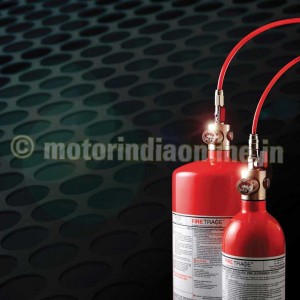 suppression agent is automatically released, extinguishing the fire precisely where it starts and before it can take hold. The tubing is placed both above and behind the potential source of fire to ensure that the airflow actually helps by directing the heat and flames towards the tubing, providing faster and more reliable detection and suppression. All Firetrace systems are available with a manual release or an “alert” signal light and horn that can be mounted on the driver’s dashboard, and the system has no negative impact on vehicle maintenance.
suppression agent is automatically released, extinguishing the fire precisely where it starts and before it can take hold. The tubing is placed both above and behind the potential source of fire to ensure that the airflow actually helps by directing the heat and flames towards the tubing, providing faster and more reliable detection and suppression. All Firetrace systems are available with a manual release or an “alert” signal light and horn that can be mounted on the driver’s dashboard, and the system has no negative impact on vehicle maintenance.
While many applications use the Firetrace direct release system, the indirect release system is the preferred solution for bus and coach engine protection. In the indirect release system, the Firetrace tube is the system’s detection and activation device. The rupturing of the tube results in a drop of pressure causing an indirect valve to activate. This diverts flow from the detection tube and the suppression agent is discharged through diffuser nozzles, flooding the entire engine enclosure.
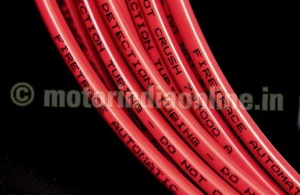 The extinguishing agent cylinder is usually mounted in the engine compartment, and the ABC dry chemical suppressant is by far the most appropriate choice for these applications. It is suitable for the suppression of ordinary combustible, electrical and flammable liquid fires that involve petrol, diesel, solvents, lubricants and spirits. However, other clean suppression agents such as DuPont FM200 gaseous suppression agent and 3M Novec 1230 fire suppression fluid are increasingly being used for the protection of hybrid buses as well as other Firetrace applications.
The extinguishing agent cylinder is usually mounted in the engine compartment, and the ABC dry chemical suppressant is by far the most appropriate choice for these applications. It is suitable for the suppression of ordinary combustible, electrical and flammable liquid fires that involve petrol, diesel, solvents, lubricants and spirits. However, other clean suppression agents such as DuPont FM200 gaseous suppression agent and 3M Novec 1230 fire suppression fluid are increasingly being used for the protection of hybrid buses as well as other Firetrace applications.
Reliable, accredited solution
The growing number of buses and coaches protected by Firetrace is evidence of the system’s ability to quickly and effectively detect 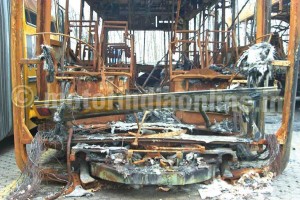 and extinguish engine fires. However, bus and coach fires choose their own time and place, and bus fires are by no means limited to older vehicles. Indeed, among the latest reported engine fires to be successfully detected and suppressed by a Firetrace system was in a vehicle less than a year old. Engine fires are no respecter of cost-cutting exercises, poor attention to detail, lack of awareness or inexperience. So installing anything other than an approved, genuine Firetrace system is a high-risk strategy with potentially dire consequences.
and extinguish engine fires. However, bus and coach fires choose their own time and place, and bus fires are by no means limited to older vehicles. Indeed, among the latest reported engine fires to be successfully detected and suppressed by a Firetrace system was in a vehicle less than a year old. Engine fires are no respecter of cost-cutting exercises, poor attention to detail, lack of awareness or inexperience. So installing anything other than an approved, genuine Firetrace system is a high-risk strategy with potentially dire consequences.
Genuine Firetrace is alone among tube-based systems in the international marketplace in having amassed a number of major international listings, approvals and accreditations. These include such organisations as Underwriters Laboratories (UL), Factory Mutual (FM) and Conformité Européene or European Conformity (CE), as well as more than 25 other internationally renowned and independent accreditation and approvals agencies, one of which is the Swedish Fire Protection Association that has confirmed Firetrace’s compliance with the SBF 128 bus fire test.
To ensure a consistently high level of customer service, ISO 9001-certified Firetrace International has created a global network of authorised Firetrace distributors. These professionally-minded trading partners are skilled in hazard analysis, experienced in agent and system selection, and trained in installation, commissioning and support. They also use only genuine Firetrace components.